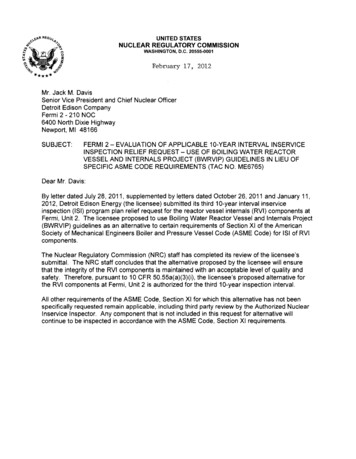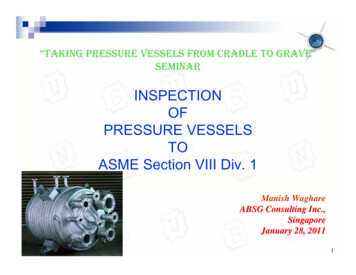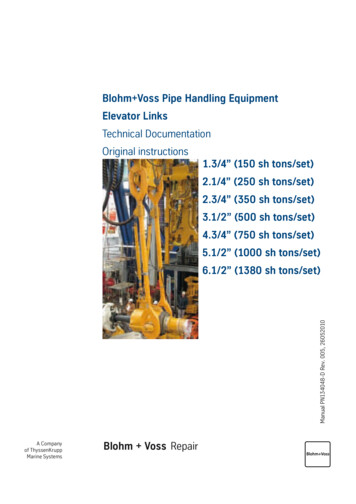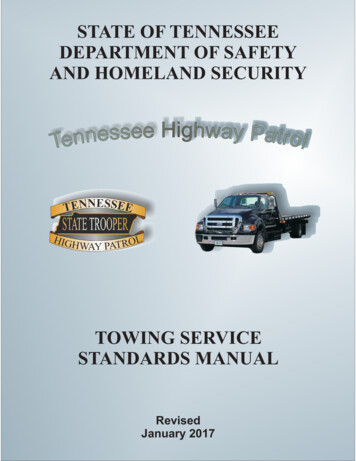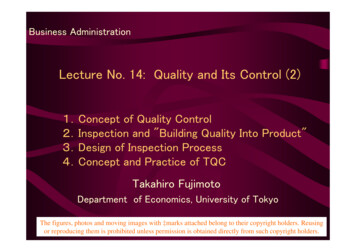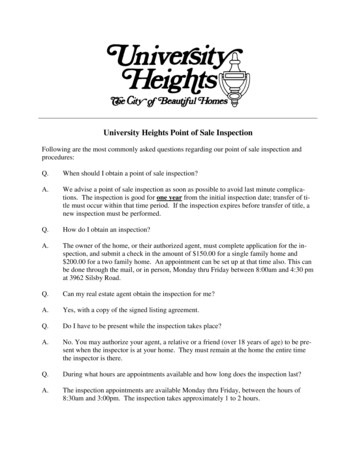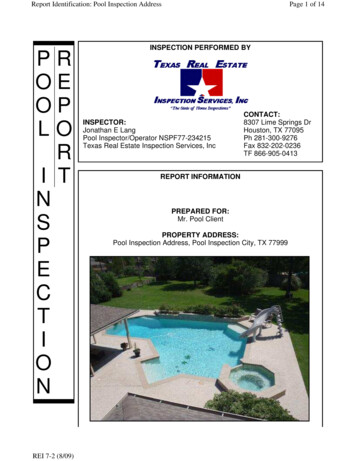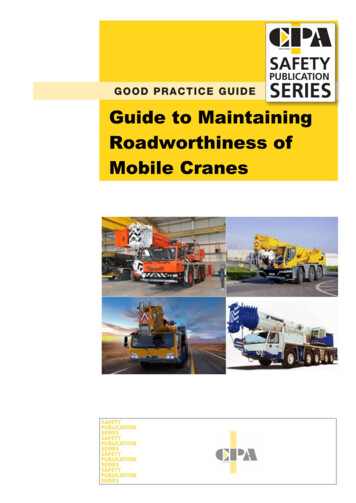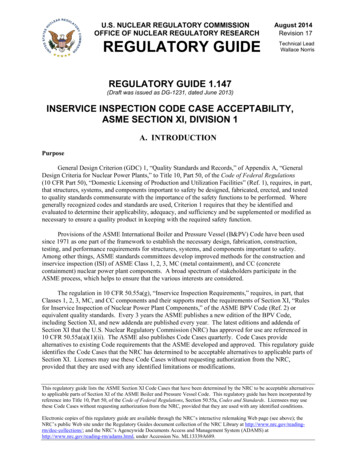
Transcription
U.S. NUCLEAR REGULATORY COMMISSIONOFFICE OF NUCLEAR REGULATORY RESEARCHREGULATORY GUIDEAugust 2014Revision 17Technical LeadWallace NorrisREGULATORY GUIDE 1.147(Draft was issued as DG-1231, dated June 2013)INSERVICE INSPECTION CODE CASE ACCEPTABILITY,ASME SECTION XI, DIVISION 1A. INTRODUCTIONPurposeGeneral Design Criterion (GDC) 1, “Quality Standards and Records,” of Appendix A, “GeneralDesign Criteria for Nuclear Power Plants,” to Title 10, Part 50, of the Code of Federal Regulations(10 CFR Part 50), “Domestic Licensing of Production and Utilization Facilities” (Ref. 1), requires, in part,that structures, systems, and components important to safety be designed, fabricated, erected, and testedto quality standards commensurate with the importance of the safety functions to be performed. Wheregenerally recognized codes and standards are used, Criterion 1 requires that they be identified andevaluated to determine their applicability, adequacy, and sufficiency and be supplemented or modified asnecessary to ensure a quality product in keeping with the required safety function.Provisions of the ASME International Boiler and Pressure Vessel (B&PV) Code have been usedsince 1971 as one part of the framework to establish the necessary design, fabrication, construction,testing, and performance requirements for structures, systems, and components important to safety.Among other things, ASME standards committees develop improved methods for the construction andinservice inspection (ISI) of ASME Class 1, 2, 3, MC (metal containment), and CC (concretecontainment) nuclear power plant components. A broad spectrum of stakeholders participate in theASME process, which helps to ensure that the various interests are considered.The regulation in 10 CFR 50.55a(g), “Inservice Inspection Requirements,” requires, in part, thatClasses 1, 2, 3, MC, and CC components and their supports meet the requirements of Section XI, “Rulesfor Inservice Inspection of Nuclear Power Plant Components,” of the ASME BPV Code (Ref. 2) orequivalent quality standards. Every 3 years the ASME publishes a new edition of the BPV Code,including Section XI, and new addenda are published every year. The latest editions and addenda ofSection XI that the U.S. Nuclear Regulatory Commission (NRC) has approved for use are referenced in10 CFR 50.55a(a)(1)(ii). The ASME also publishes Code Cases quarterly. Code Cases providealternatives to existing Code requirements that the ASME developed and approved. This regulatory guideidentifies the Code Cases that the NRC has determined to be acceptable alternatives to applicable parts ofSection XI. Licenses may use these Code Cases without requesting authorization from the NRC,provided that they are used with any identified limitations or modifications.This regulatory guide lists the ASME Section XI Code Cases that have been determined by the NRC to be acceptable alternativesto applicable parts of Section XI of the ASME Boiler and Pressure Vessel Code. This regulatory guide has been incorporated byreference into Title 10, Part 50, of the Code of Federal Regulations, Section 50.55a, Codes and Standards. Licensees may usethese Code Cases without requesting authorization from the NRC, provided that they are used with any identified conditions.Electronic copies of this regulatory guide are available through the NRC’s interactive rulemaking Web page (see above); theNRC’s public Web site under the Regulatory Guides document collection of the NRC Library at http://www.nrc.gov/readingrm/doc-collections/; and the NRC’s Agencywide Documents Access and Management System (ADAMS) athttp://www.nrc.gov/reading-rm/adams.html, under Accession No. ML13339A689.
Section XI Code Cases not yet endorsed by the NRC may be used by a licensee or applicantthrough 10 CFR 50.55a(z). That section permits the use of alternatives to the Code requirementsreferenced in 10 CFR 50.55a provided that the proposed alternatives result in an acceptable level ofquality and safety and that their use is authorized by the Director of the Office of Nuclear ReactorRegulation.The ASME Code is incorporated by reference into 10 CFR 50.55a, which the NRC will amend toincorporate this guide by reference; 10 CFR 50.55a states the requirements governing the use of CodeCases. Because of continuing change in the status of Code Cases, the staff plans periodic updates to10 CFR 50.55a and this guide to accommodate new Code Cases and any revisions of existing CodeCases. Code Cases approved by the NRC provide an acceptable voluntary alternative to the mandatoryASME Code provisions.Paperwork Reduction Act StatementThis regulatory guide does not contain new or amended information collection requirementssubject to the Paperwork Reduction Act of 1995 (44 U.S.C. 3501 et seq.) (Ref. 3). Existing informationcollection requirements were approved by the Office of Management and Budget, control number 31500011.Public Protection NotificationThe NRC may not conduct or sponsor, and a person is not required to respond to, a request forinformation or an information collection requirement unless the requesting document displays a currentlyvalid OMB control number.This regulatory guide is a rule as designated in the Congressional Review Act (5 U.S.C. 801-808)(Ref. 13). However, the NRC has determined this regulatory guide is not a major rule as designated bythe Congressional Review Act and has verified this determination with the OMB.Revision 17 of RG 1.147, Page 2
B. DISCUSSIONFor Revision 17 of Regulatory Guide 1.147, the NRC reviewed the Section XI Code Cases listedin Supplements 1 through 10 to the 2007 Edition of the ASME BPV Code. Appendix A to this guide liststhe supplements reviewed, the edition, the supplement number, and the date on which the supplement wasapproved by the ASME Board on Nuclear Codes and Standards. Appendix B is a list of the Section XICode Cases published by the ASME in the seven supplements. Finally, Appendix C is a current list of allSection XI Code Cases. The Code Cases addressed by this regulatory guide are listed in five tables:(1)Table 1, “Acceptable Section XI Code Cases,” lists the Code Cases that are acceptable to theNRC for implementation in the ISI of light-water-cooled nuclear power plants.(2)Table 2, “Conditionally Acceptable Section XI Code Cases,” lists the Code Cases that areacceptable, provided that they are used with the identified conditions (i.e., the Code Case isgenerally acceptable but the NRC has determined that the requirements in the Code Case, whichare an alternative to requirements in the BPV Code, must be supplemented in order to provide anacceptable level of quality and safety).(3)Table 3, “Annulled Unconditionally Approved Section XI Code Cases,” lists Code Cases annulledby the ASME that the NRC previously determined to be fully acceptable.(4)Table 4, “Annulled Conditionally Acceptable Section XI Code Cases,” lists Code Cases that theNRC determined to be acceptable, provided that they were used with the identified conditions,but were subsequently annulled by the ASME.(5)Table 5, “Section XI Code Cases That Have Been Superseded by Revised Code Cases,” listsCode Cases that have been superseded through revision.Code Cases that the NRC has determined to be unacceptable are listed in Regulatory Guide1.193, “ASME Code Cases Not Approved for Use” (Ref. 4).Code Cases provide alternatives to existing Code requirements that the ASME developed andapproved. The new Code Cases and revisions to existing Code Cases listed as approved in Tables 1 and 2of this guide will be incorporated by reference into 10 CFR 50.55a. Code Cases approved by the NRCmay be used voluntarily by licensees as an alternative to compliance with ASME Code provisionsincorporated by reference into 10 CFR 50.55a.When a licensee initially implements a Code Case, 10 CFR 50.55a requires that the most recentversion of that Code Case as listed in Tables 1 and 2 be implemented. If a Code Case is implemented bya licensee and a later version of the Code Case is incorporated by reference into 10 CFR 50.55a and listedin Tables 1 and 2 during the licensee’s present 120-month ISI program interval, that licensee may useeither the later version or the previous version. An exception to this provision would be the inclusionof a limitation or condition on the use of the Code Case that is necessary, for example, to enhance safety.Licensees who choose to continue use of the Code Case during the subsequent 120-month ISI programinterval will be required to implement the latest version incorporated by reference into 10 CFR 50.55aand listed in Tables 1 and 2.Code Cases may be annulled because the provisions have been incorporated into the Code, theapplication for which it was specifically developed no longer exists, or experience has shown that anexamination or testing method is no longer adequate. After a Code Case is annulled and 10 CFR 50.55aand this guide are amended, licensees may not implement that Code Case for the first time. However, aRevision 17 of RG 1.147, Page 3
licensee who implemented the Code Case prior to annulment may continue to use that Code Case throughthe end of the present ISI interval. An annulled Code Case cannot be used in the subsequent ISI intervalunless implemented as an approved alternative under 10 CFR 50.55a(z). If a Code Case is incorporatedby reference into 10 CFR 50.55a and later annulled by the ASME because experience has shown that anexamination or testing method is inadequate, the NRC will amend 10 CFR 50.55a and this guide toremove the approval of the annulled Code Case. Licensees should not begin to implement such annulledCode Cases prior to the rulemaking. Notwithstanding these requirements, the Commission may imposenew or revised Code requirements, including implementation schedules, that it determines are consistentwith the Backfit Rule (10 CFR 50.109).Code Cases may be revised, for example, to incorporate user experience. The older or supersededversion of the Code Case cannot be applied by the licensee or applicant for the first time. If an applicantor a licensee applied a Code Case before it was listed as superseded, the applicant or the licensee maycontinue to use the Code Case until the applicant or the licensee updates its construction Code of Record(in the case of an applicant, updates its application) or until the licensee’s 120-month ISI update intervalexpires, after which the continued use of the Code Case is prohibited unless NRC approval is grantedunder 10 CFR Part 50.55a(z). If a Code Case is incorporated by reference into 10 CFR Part 50.55a andlater a revised version is issued by the ASME because experience has shown that the design analysis,construction method, examination method, or testing method is inadequate; the NRC will amend 10 CFRPart 50.55a and the relevant RG to remove the approval of the superseded Code Case. Applicants andlicensees should not begin to implement such superseded Code Cases in advance of the rulemaking.With regard to the use of any Code Case, it is the responsibility of the user to make certain thatthe provisions of the Code Case do not conflict with regulatory requirements or licensee commitments.Revision 17 of RG 1.147, Page 4
C. STAFF REGULATORY GUIDANCE1.Acceptable Section XI Code CasesThe Code Cases listed in Table 1 are acceptable to the NRC for application in licensee’sSection XI inservice inspection programs. The 2010 Edition of the ASME BPV Code was published onJuly 1, 2010. The ASME will issue a new edition of Section XI in 2011 and every two years thereafter.Code Cases will continue to be published quarterly in supplements to each edition.Table 1. Acceptable Section XI Code CasesCode CaseNumberTable 1Acceptable Section XI Code CasesDateN-432-1Repair Welding Using Automatic or Machine Gas Tungsten-Arc Welding(GTAW) Temper Bead Technique, Section XI, Division 13/28/01N-460Alternative Examination Coverage for Class 1 and Class 2 Welds,Section XI, Division 12/14/03N-491-2Rules for Examination of Class 1, 2, 3, and MC Component Supports of LightWater Cooled Power Plants, Section XI, Division 12/14/03N-494-4Pipe Specific Evaluation Procedures and Acceptance Criteria for Flaws inClass 1 Ferritic Piping that Exceed the Acceptance Standards of IWB-3514.2and in Class 1 Austenitic Piping that Exceed the Acceptance Standards ofIWB-3514.3, Section XI, Division1/12/05N-496-2Helical-Coil Threaded Inserts, Section XI, Division 18/04/04N-517-1Quality Assurance Program Requirements for Owners, Section XI, Division 13/28/01N-526Alternative Requirements for Successive Inspections of Class 1 and 2 Vessels,Section XI, Division 18/20/02N-532-5Alternative Requirements to Repair and Replacement DocumentationRequirements and Inservice Summary Report Preparation and Submission asRequired by IWA-4000 and IWA-6000, Section XI, Division 11/04/11N-534Alternative Requirements for Pneumatic Pressure Testing, Section XI,Division 15/09/03N-537Location of Ultrasonic Depth-Sizing Flaws, Section XI, Division 13/28/01N-553-1Inservice Eddy Current Surface Examination of Pressure Retaining Pipe Weldsand Nozzle-to-Safe End Welds, Section XI, Division 13/28/01N-554-3Alternative Requirements for Reconciliation of Replacement Items and Additionof New Systems, Section XI, Division 12/14/03N-566-2Corrective Action for Leakage Identified at Bolted Connections, Section XI,Division 13/28/01Revision 17 of RG 1.147, Page 5
Code CaseNumberTable 1Acceptable Section XI Code CasesDateN-567-1Alternative Requirements for Class 1, 2, and 3 Replacement Components,Section XI, Division 14/19/02N-573Transfer of Procedure Qualification Records Between Owners, Section XI,Division 12/14/03N-586-1Alternative Additional Examination Requirements for Classes 1, 2, and 3 Piping,Components, and Supports, Section XI, Division 15/04/04N-600Transfer of Welder, Welding Operator, Brazer, and Brazing OperatorQualifications Between Owners, Section XI, Division 19/18/01N-609Alternative Requirements to Stress-Based Selection Criteria for Category B-JWelds, Section XI, Division 17/30/98N-613-1Ultrasonic Examination of Penetration Nozzles in Vessels, ExaminationCategory B-D, Item Nos. B3.10 and B3.90, Reactor Nozzle-to-Vessel Welds,Figs. IWB-2500-7(a), (b), and (c), Section XI, Division 18/20/02N-624Successive Inspections, Section XI, Division 14/19/02N-629Use of Fracture Toughness Test Data to Establish Reference Temperature forPressure Retaining Materials, Section XI, Division 18/20/02N-641Alternative Pressure-Temperature Relationship and Low TemperatureOverpressure Protection System Requirements, Section XI, Division 12/03/03N-643-2Fatigue Crack Growth Rate Curves for Ferritic Steels in PWR WaterEnvironment, Section XI, Division 15/04/04N-649Alternative Requirements for IWE-5240 Visual Examination, Section XI,Division 13/28/01N-651Ferritic and Dissimilar Metal Welding Using SMAW Temper Bead TechniqueWithout Removing the Weld Bead Crown for the First Layer, Section XI,Division 18/14/01N-652-1Alternative Requirements to Categorize B-G-1, B-G-2, and C-D BoltingExamination Methods and Selection Criteria, Section XI, Division 12/20/04N-658Qualification Requirements for Ultrasonic Examination of Wrought AusteniticPiping Welds, Section XI, Division 14/4/02N-663Alternative Requirements for Classes 1 and 2 Surface Examinations,Section XI, Division 19/17/02N-664Performance Demonstration Requirements for Examination of Unclad ReactorPressure Vessel Welds, Excluding Flange Welds, Section XI, Division 18/20/02N-665Alternative Requirements for Beam Angle Measurements Using RefractedLongitudinal Wave Search Units, Section XI, Division 12/28/03Revision 17 of RG 1.147, Page 6
Code CaseNumberTable 1Acceptable Section XI Code CasesDateN-666Weld Overlay of Class 1, 2, and 3 Socket Welded Connections, Section XI,Division 14/18/06N-683Method for Determining Maximum Allowable False Calls When PerformingSingle-Sided Access Performance Demonstration in Accordance withAppendix VIII, Supplements 4 and 6, Section XI, Division 12/28/03N-685Lighting Requirements for Surface Examination, Section XI, Division 12/28/03N-686-1Alternative Requirements for Visual Examinations, VT-1, VT-2, and VT-3,Section XI, Division1/10/07N-695Qualification Requirements for Dissimilar Metal Piping Welds, Section XIDivision 15/21/03N-696Qualification Requirements for Appendix VIII Piping Examinations Conductedfrom the Inside Surface, Section XI, Division 15/21/03N-697Pressurized Water Reactor (PWR) Examination and Alternative ExaminationRequirements for Pressure Retaining Welds in Control Rod Drive andInstrument Nozzle Housings, Section XI, Division 111/18/03N-700Alternative Rules for Selection of Classes 1, 2, and 3 Vessel Welded Attachmentsfor Examination, Section XI, Division 111/18/03N-705Evaluation Criteria for Temporary Acceptance of Degradation in ModerateEnergy Class 2 or 3 Vessels and Tanks, Section XI, Division 110/12/06N-706-1Alternative Examination Requirements of Table IWB-2500-1 and TableIWC-2500-1 for PWR Stainless Steel Residual and Regenerative HeatExchangers, Section XI, Division 11/10/07N-712Class 1 Socket Weld Examinations, Section XI, Division 15/12/04N-716-1Alternative Piping Classification and Examination Requirements, Section XI,Division 11/27/13N-730Roll Expansion of Class 1 Control Rod Drive Bottom Head Penetrations inBWRs, Section XI, Division 110/04/06N-731Alternative Class 1 System Leakage Test Pressure Requirements, Section XI,Division 12/22/05N-733Mitigation of Flaws in NPS 2 (DN 50) and Smaller Nozzles and Nozzle PartialPenetration Welds in Vessels and Piping by Use of a Mechanical ConnectionModification, Section XI, Division 17/01/05N-735Successive Inspection of Class 1 and 2 Piping Welds, Section XI, Division 110/12/06Revision 17 of RG 1.147, Page 7
Code CaseNumberTable 1Acceptable Section XI Code CasesDateN-739-1Alternative Qualification Requirements for Personnel Performing Class CCConcrete and Post-Tensioning System Visual Examinations, Section XI,Division 11/21/07N-747Reactor Vessel Head-to-Flange Weld Examinations, Section XI, Division 11/13/06N-753Vision Tests, Section XI, Division 17/14/06N-762Temper Bead Procedure Qualification Requirements for Repair/ReplacementActivities Without Post Weld Heat Treatment, Section XI, Division 11/21/07N-765Alternative to Inspection Interval Scheduling Requirements of IWA-2430,Section XI, Division 11/26/09N-769Roll Expansion of Class 1 In-Core Housing Bottom Head Penetrations inBWRs, Section XI, Division 11/26/09N-773Alternative Qualification Criteria for Eddy Current Examinations of PipingInside Surfaces, Section XI, Division 11/26/09Revision 17 of RG 1.147, Page 8
2.Conditionally Acceptable Section XI Code CasesThe Code Cases listed in Table 2 are acceptable to the NRC for application in licensee’sSection XI inservice inspection programs within the limitations imposed by the NRC staff. Unlessotherwise stated, limitations imposed by the NRC are in addition to the conditions specified in the CodeCase. The ASME will issue a new edition of Section XI in 2011 and every two years thereafter. CodeCases will continue to be published quarterly in supplements to each edition.Table 2. Conditionally Acceptable Section XI Code CasesCode CaseNumberTable 2Conditionally Acceptable Section XI Code CasesDateConditionN-416-4Alternative Pressure Test Requirement for Welded or Brazed Repairs,Fabrication Welds or Brazed Joints for Replacement Parts and PipingSubassemblies, or Installation of Replacement Items by Welding or Brazing,Classes 1, 2, and 3, Section XI, Division 11/12/05Nondestructive examination shall be performed on welded or brazed repairs andfabrication and installation joints in accordance with the methods and acceptancecriteria of the applicable subsection of the 1992 Edition of Section III.N-498-4Alternative Requirements for 10-Year System Hydrostatic Testing for Class 1, 2,and 3 Systems, Section XI, Division 14/08/02Prior to conducting the VT-2 examination of Class 2 and Class 3 components notrequired to operate during normal plant operation, a 10-minute holding time isrequired after attaining test pressure. Prior to conducting the VT-2 examinationof Class 2 and Class 3 components required to operate during normal plantoperation, no holding time is required, provided the system has been in operationfor at least 4 hours for insulated components or 10 minutes for non-insulatedcomponents.N-504-4Alternative Rules for Repair of Class 1, 2, and 3 Austenitic Stainless Steel Piping,Section XI, Division 1The provisions of Section XI, Nonmandatory Appendix Q, “Weld Overlay Repairof Class 1, 2, and 3 Austenitic Stainless Steel Piping Weldments,” must also bemet. In addition, the following conditions shall be met: (a) the sum of laminarflaw length in any direction shall be less than 10% of the overlay with a totalreduction in area equal to or less than Table IWB-3514-3; (b) the finished overlaysurface shall be 250 micro-in (6.3 micrometers) root mean square or smoother; (c)the surface flatness shall be adequate for ultrasonic examination; and (d)radiography shall not be used to detect planar flaws under or masked by laminarflaws.Revision 17 of RG 1.147, Page 97/14/06
Code CaseNumberTable 2Conditionally Acceptable Section XI Code CasesDateConditionN-508-4Rotation of Serviced Snubbers and Pressure Retaining Items for the Purpose ofTesting, Section XI, Division 11/26/09When Section XI requirements are used to govern the examination and testing ofsnubbers and the ISI Code of Record is earlier than Section XI, 2006 Addenda,Footnote 1 shall not be applied.N-513-3Evaluation Criteria for Temporary Acceptance of Flaws in Moderate EnergyClass 2 or 3 Piping, Section XI, Division 11/26/09The repair or replacement activity temporarily deferred under the provisions ofthis Code Case shall be performed during the next scheduled outage.N-516-3Underwater Welding, Section XI, Division 14/08/02Licensees must obtain NRC approval in accordance with 10 CFR 50.55a(z)regarding the technique to be used in the weld repair or replacement of irradiatedmaterial underwater.N-528-1Purchase, Exchange, or Transfer of Material Between Nuclear Plant Sites,Section XI, Division 14/19/02The requirements of 10 CFR Part 21, “Reporting of Defects and Noncompliance”(Ref. 5), are to be applied to the nuclear plant site supplying the material as wellas to the nuclear plant site receiving the material that has been purchased,exchanged, or transferred between sites.N-533-1Alternative Requirements for VT-2 Visual Examination of Class 1, 2, and 3Insulated Pressure-Retaining Bolted Connections, Section XI, Division 14/08/02Prior to conducting the VT-2 examination of Class 2 and Class 3 components notrequired to operate during normal plant operation, a 10 minute holding time isrequired after attaining test pressure. Prior to conducting the VT-2 examinationof Class 2 and Class 3 components required to operate during normal plantoperation, no holding time is required, provided the system has been in operationfor at least 4 hours for insulated components or 10 minutes for non-insulatedcomponents.N-552Alternative Methods - Qualification for Nozzle Inside Radius Section from theOutside Surface, Section XI, Division 1To achieve consistency with the 10 CFR 50.55a rule change publishedSeptember 22, 1999 (64 FR 51370), incorporating Appendix VIII, “PerformanceDemonstration for Ultrasonic Examination Systems,” to Section XI, add thefollowing to the specimen requirements:“At least 50 percent of the flaws in the demonstration test set must be cracks andthe maximum misorientation must be demonstrated with cracks. Flaws in nozzleswith bore diameters equal to or less than 4 inches may be notches.”Add to detection criteria, “The number of false calls must not exceed three.”Revision 17 of RG 1.147, Page 104/19/02
Code CaseNumberTable 2Conditionally Acceptable Section XI Code CasesDateConditionN-557-1In-Place Dry Annealing of a PWR Nuclear Reactor Vessel, Section XI,Division 18/20/02The secondary stress allowable of 3Sm, shown in Figure 1 of the Code Case, mustbe applied to the entire primary plus secondary stress range during the anneal.N-561-2Alternative Requirements for Wall Thickness Restoration of Class 2 and HighEnergy Class 3 Carbon Steel Piping, Section XI, Division 13/22/07(1) Paragraph 5(b): for repairs performed on a wet surface, the overlay is onlyacceptable until the next refueling outage.(2) Paragraph 7(c): if the cause of the degradation has not been determined, therepair is only acceptable until the next refueling outage.(3) The area where the weld overlay is to be applied must be examined usingultrasonic methods to demonstrate that no crack-like defects exist.(4) Piping with wall thickness less than the diameter of the electrode shall bedepressurized before welding.N-562-2Alternative Requirements for Wall Thickness Restoration of Class 3 ModerateEnergy Carbon Steel Piping, Section XI, Division 13/22/07(1) Paragraph 5(b): for repairs performed on a wet surface, the overlay is onlyacceptable until the next refueling outage.(2) Paragraph 7(c): if the cause of the degradation has not been determined, therepair is only acceptable until the next refueling outage.(3) The area where the weld overlay is to be applied must be examined usingultrasonic methods to demonstrate that no crack-like defects exist.(4) Piping with wall thickness less than the diameter of the electrode shall bedepressurized before welding.N-569-1Alternative Rules for Repair by Electrochemical Deposition of Class 1 and 2Steam Generator Tubing, Section XI, Division 1NOTES: Steam generator tube repair methods require prior NRC approvalthrough the Technical Specifications. This Code Case does not address certainaspects of this repair, e.g., the qualification of the inspection and plugging criterianecessary for staff approval of the repair method. In addition, if the user plans to“reconcile,” as described in Footnote 2, the reconciliation is to be performedin accordance with IWA-4200 in the 1995 Edition, 1996 Addenda of ASMESection XI.Revision 17 of RG 1.147, Page 114/19/02
Code CaseNumberTable 2Conditionally Acceptable Section XI Code CasesDateConditionN-576-1Repair of Class 1 and 2 SB-163, UNS N06600 Steam Generator Tubing,Section XI, Division 14/19/02NOTES: Steam generator tube repair methods require prior NRC approvalthrough the Technical Specifications. This Code Case does not address certainaspects of this repair, e.g., the qualification of the inspection and plugging criterianecessary for staff approval of the repair method. In addition, if the user plans to“reconcile,” as described in Footnote 2, the reconciliation is to be performedin accordance with IWA-4200 in the 1995 Edition, 1996 Addenda of ASMESection XI.N-583Annual Training Alternative, Section XI, Division 12/14/03(1) Supplemental practice shall be performed on material or welds that containcracks, or by analyzing prerecorded data from material or welds that containcracks.(2) The training must be completed no earlier than 6 months prior to performingultrasonic examinations at a licensee’s facility.N-593Alternative Examination Requirements for Steam Generator Nozzle to VesselWelds, Section XI, Division 12/14/03Essentially 100 percent (not less than 90 percent) of the examination volumeA-B-C-D-E-F-G-H must be inspected.N-597-2Requirements for Analytical Evaluation of Pipe Wall Thinning, Section XI,Division 1(1) Code Case must be supplemented by the provisions of EPRI Nuclear SafetyAnalysis Center Report 202L-R2,“Recommendations for an Effective FlowAccelerated Corrosion Program” (Ref. 6), April 1999, for developing theinspection requirements, the method of predicting the rate of wall thicknessloss, and the value of the predicted remaining wall thickness. As used inNSAC-202L-R2, the term “should” is to be applied as “shall”(i.e., a requirement).(2) Components affected by flow-accelerated corrosion to which this Code Caseare applied must be repaired or replaced in accordance with the constructioncode of record and Owner’s requirements or a later NRC approved edition ofSection III, “Rules for Construction of Nuclear Power Plant Components,”of the ASME Code (Ref. 7) prior to the value of tp reaching the allowableminimum wall thickness, tmin, as specified in -3622.1(a)(1) of this CodeCase. Alternatively, use of the Code Case is subject to NRC review andapproval per 10 CFR 50.55a(z).(3) For Class 1 piping not meeting the criteria of -3221, the use of evaluationmethods and criteria is subject to NRC review and approval per 10 CFR50.55a(z).Revision 17 of RG 1.147, Page 1211/18/03
Code CaseNumberTable 2Conditionally Acceptable Section XI Code CasesDateConditionN-597-2(cont’d)Requirements for Analytical Evaluation of Pipe Wall Thinning, Section XI,Division 111/18/03(4) For those components that do not require immediate repair or replacement,the rate of wall thickness loss is to be used to determine a suitable inspectionfrequency so that repair or replacement occurs prior to reaching allowableminimum wall thickness, tmin.(5) For corrosion phenomenon other than flow accelerated corrosion, use of theCode Case is subject to NRC review and approval. Inspection plans andwall thinning rates may be difficult to justify for certain degradationmechanisms such as MIC and pitting.(6) The evaluation criteria in Code Case N-513-2 may be applied to Code CaseN-597-2 for the temporary acceptance of wall thinning (until the nextrefueling outage) for moderate-energy Class 2 and 3 piping. Moderateenergy piping is defined as Class 2 and 3 piping whose maximum operatingtemperature does not exceed 200 F (93 C) and whose maximum operatingpressure does not exceed 275 psig (1.9MPa). Code Case N-597-2 shall notbe used to evaluate through-wall leakage conditions.N-606-1Similar and Dissimilar Metal Welding Using Ambient Temperature MachineGTAW Temper Bead Technique for BWR CRD Housing/Stub Tube Repairs,Sectio
Section XI inservice inspection programs. The 2010 Edition of the ASME BPV Code was published on July 1, 2010. The ASME will issue a new edition of Section XI in 2011 and every two years thereafter. Code Cases will continue to be published quarterly in supplements to each edition. Table 1. Acceptable Section XI Code Cases Code Case Number Table 1


